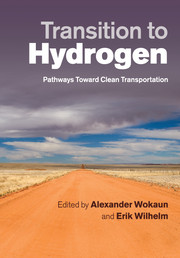Book contents
- Frontmatter
- Contents
- Contributors
- Foreword: on the transition to hydrogen
- Preface
- Executive summary
- Abbreviations
- 1 Introduction
- 2 Life cycle assessment of hydrogen production
- 3 Technical characterisation and multi-criteria analysis of light-duty vehicles
- 4 Hydrogen emissions to the atmosphere from industry and transportation
- 5 Regional fleet simulation
- 6 Long-term scenarios of the global energy and transport system
- 7 Integrated assessment of hydrogen in transportation
- Appendix A Summary of fundamental assumptions
- Appendix B Selected input assumptions, technology descriptions, and heuristics
- Appendix C Characteristics of the present and future vehicle designs
- Appendix D Survey questionnaire and aggregated responses
- Appendix E Assumptions and inputs driving fleet dynamics simulation
- References
- Index
- Plates
3 - Technical characterisation and multi-criteria analysis of light-duty vehicles
Published online by Cambridge University Press: 05 November 2011
- Frontmatter
- Contents
- Contributors
- Foreword: on the transition to hydrogen
- Preface
- Executive summary
- Abbreviations
- 1 Introduction
- 2 Life cycle assessment of hydrogen production
- 3 Technical characterisation and multi-criteria analysis of light-duty vehicles
- 4 Hydrogen emissions to the atmosphere from industry and transportation
- 5 Regional fleet simulation
- 6 Long-term scenarios of the global energy and transport system
- 7 Integrated assessment of hydrogen in transportation
- Appendix A Summary of fundamental assumptions
- Appendix B Selected input assumptions, technology descriptions, and heuristics
- Appendix C Characteristics of the present and future vehicle designs
- Appendix D Survey questionnaire and aggregated responses
- Appendix E Assumptions and inputs driving fleet dynamics simulation
- References
- Index
- Plates
Summary
Introduction
Over half of all oil is used in transportation, and global demand is steadily increasing (EIA, 2008a). The exclusive dependence of our mobility on fossil fuels raises serious concerns over energy security, cost, environment, and human health. Creating a more sustainable transportation system has been the subject of much attention from stakeholders in the governmental, consumer, and industrial arenas (Kasseris, 2006; Stern, 2006). Technological developments are necessary to move toward sustainability in personal transportation while meeting dramatically increasing demand for mobility from developing countries, particularly India and China (IEA, 2008b: 393, Table 16.4). Carmakers understand that consumers will not readily tolerate any reduction in the quality of service provided (Stremler, 2008) while at the same time government is expected to regulate industry to protect human health and mitigate climate change. There are no easy answers to the transportation energy question, and there is a clear need for an accurate description of the inherentlydifficult trade-offs associated with vehicle technology options.
In the near term, improvements in vehicle efficiency can be achieved by incremental modifications in combustion engines, accessory load reduction, low-rolling-resistance tyres, and downsizing/lightweighting (Weiss et al., 2000; MacLean and Lave, 2003). In the long term, fuel cells and batteries with high-energy densities promise to drastically reduce transportation emissions at constant performance and safety. The trend toward powertrain electrification introduces not only a new set of technical challenges but also many new supply chain and social acceptance challenges. Biofuel is another alternative that is being actively researched and developed, but often faces hurdles when considering land-use change (Hertel, 2009) among other things. There tends to be bias in the various whitepapers and technical reports released by the lobby groups of the respective transportation technology developers, each attempting to present the facts in a way that promotes their own technology over their competitors.
- Type
- Chapter
- Information
- Transition to HydrogenPathways Toward Clean Transportation, pp. 58 - 95Publisher: Cambridge University PressPrint publication year: 2011
- 1
- Cited by



